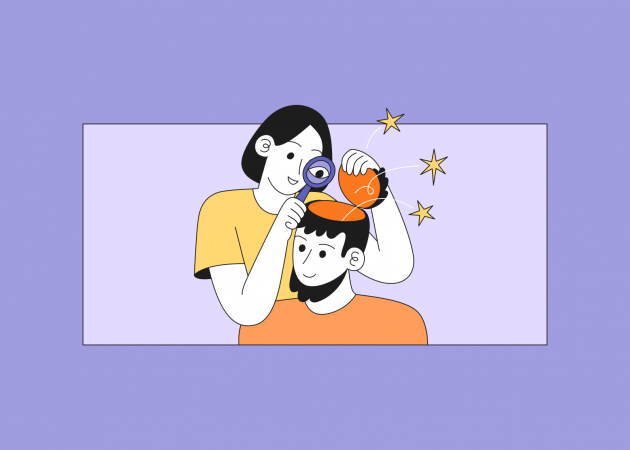
Skills to Look for When Hiring Healthtech Developers for Long-Term Project Success
Contents
Contents
No secret that health applications require specialized domain expertise. Given the global scarcity of engineers proficient in healthcare software development, recruiting a local team can take time and effort, slowing your progress. It is one of the reasons why organizations increasingly choose to hire development partners with a proven track record in the medical field to extend their tech teams or implement projects in any area of healthcare technology.
It is beyond the scope of one article to cover every conceivable area of knowledge, but let’s go over as many fundamental things your developers should be familiar with before starting a project as possible.
Types of in-demand healthcare apps
Whether you are hiring in-house developers or a software company for your venture, let’s first look at the most popular apps for healthcare. After all, all upcoming functional and technology choices depend on your project’s general idea and target audience. And while our diagram doesn’t cover all possible applications that exist, it outlines the range of potential development vectors:
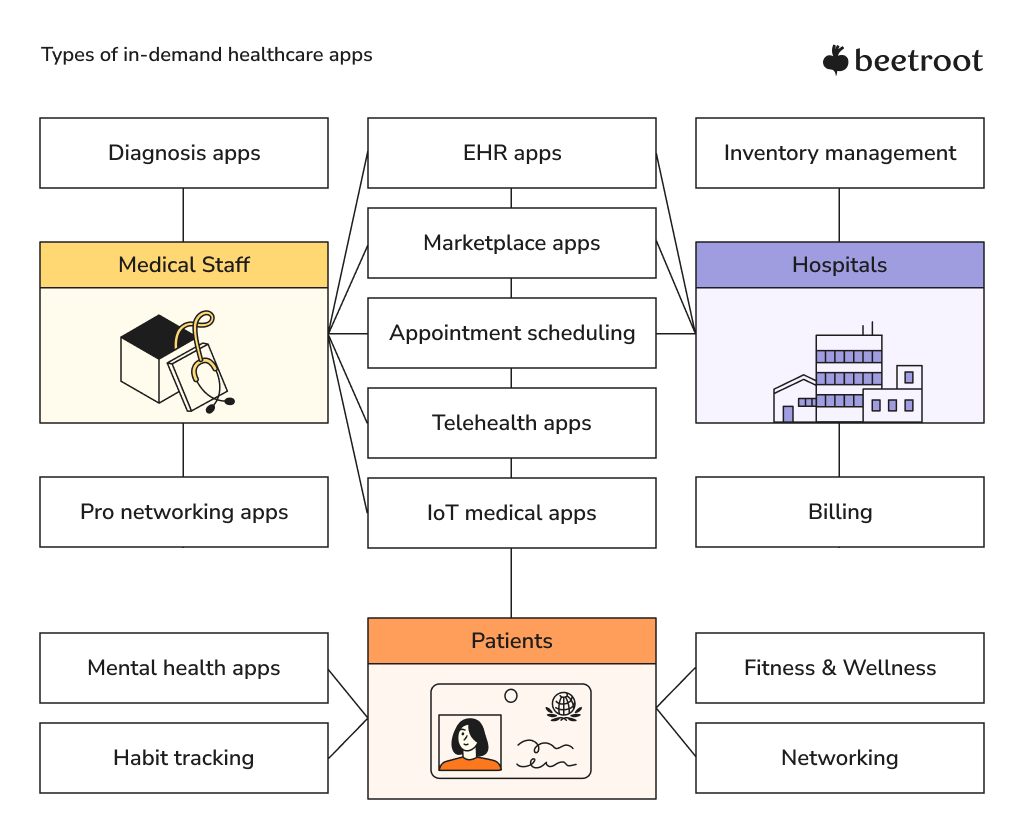
Apps for medical personnel
Doctors and nurses use medical applications for patient management, staff training, and various administrative tasks:
- Doctors/nurses marketplaces;
- Electronic Health/Medical Records (EHR/EMR);
- Inventory management;
- Billing and payments;
- Practice management;
- Networking tools, and more.
Applications for hospitals and care providers
Hospitals have their existing operating capabilities and processes in place. Please remember that these apps are subject to stringent privacy policies and compliance standards — we’ll talk about them in a while. Pro solutions cover:
- Remote patient monitoring;
- Diagnostics support;
- Telemedicine;
- EHR/EMR;
- Medical references;
- Hospital ERP mobile apps;
- Clinical communication;
- Scheduling and appointment management.
Health applications for patients
These mobile applications function from a patient’s perspective. At some point, they can overlap with professional solutions and include:
- Appointment scheduling and reminders;
- Habit tracking;
- Fitness and wellness;
- Self-diagnostics;
- Communication platforms;
- Mental health apps;
- Telehealth;
- IoT medical products;
- Women’s health, and more.

Knowledge of local regulatory standards
Health apps process massive volumes of sensitive data. As a result, it is critical for your development team to be aware of and to comply with specific standards to manage health information properly. Don’t worry that you’ll have to figure out all the intricacies of these regulations on your own: your team provider will certainly supply you with a certified compliance expert.
While this is not a complete list of laws and regulations, it does include the most important ones, broken down by regions:
USA
HIPAA (The Health Insurance Portability and Accountability Act) protects the privacy and security of all individually identifiable data. So all healthcare apps designed for the US market must be HIPAA-compliant. The HITECH Act broadens the scope of HIPAA and establishes specific requirements for healthcare facilities to use when implementing EHRs. Finally, on a local level, the CCPA regulation secures the privacy rights of California residents.
Canada
PIPEDA (Personal Information Protection Electronic Documents Act) is a Canadian federal data privacy law governing personal data collection, use, and exposure for commercial use. PIPEDA compliance requires you to obtain meaningful consent from users to gather and handle their personal information.
United Kingdom
The Data Protection Act (DPA) and the Common Law Duty of Confidentiality (CLDC) are the legal frameworks in the United Kingdom that govern how patient data must be handled and processed. The Data Protection Act is the UK’s adaptation of the General Data Protection Regulation (GDPR).
European Union
GDPR is arguably the strictest privacy and data protection regulation in the world. In addition to the standard safeguards for personal data, the GDPR outlines three forms of “health data” that require specific protection: health-related data, genetic data, and biometric data. These classify as sensitive personal data, and the GDPR typically bars their processing unless explicit consent is given or particular requirements are met.
If you also want your product to be certified by a government regulator like FDA in the US or Health Canada in Canada, you have to follow a certain number of additional rules. And these rules and standards change from time to time, requiring even more work from the software developers.
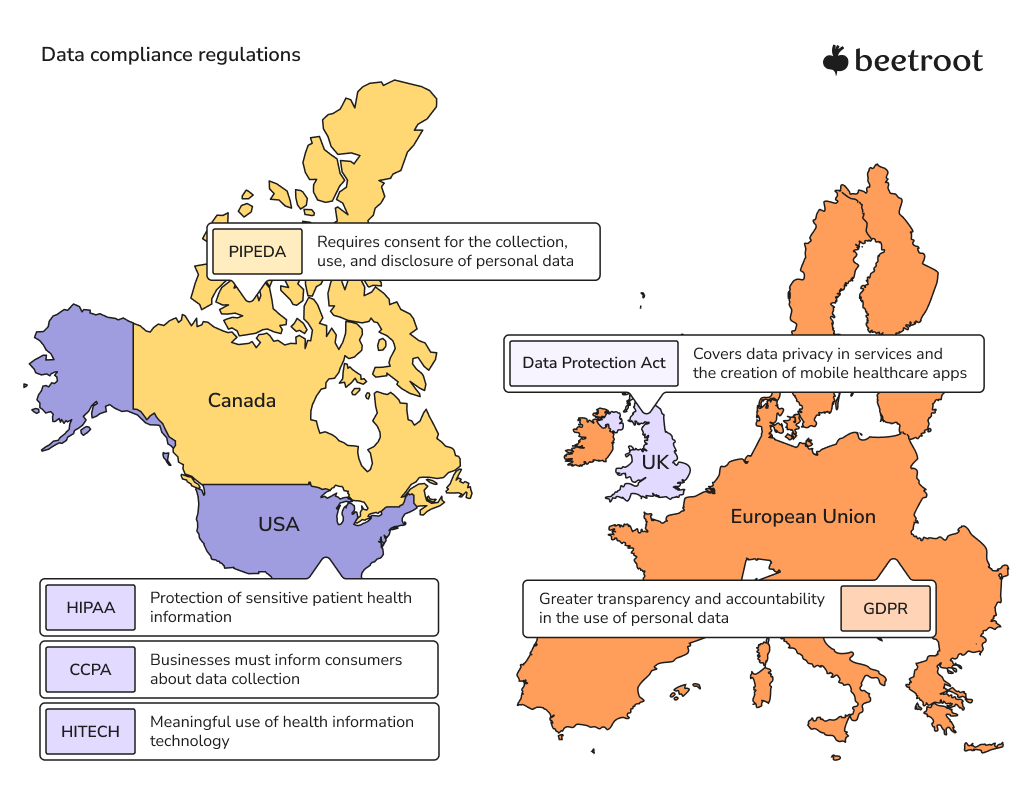
Knowledge of healthcare API integrations and development
APIs (Application Programming Interfaces) facilitate software development through ready-to-use and tested third-party services. Specialized healthcare APIs allow you to solve complex clinical problems and integrate all features into one app rather than designing them from scratch. Therefore, your team needs a developer(s) familiar with the technology.
Electronic Health Records APIs
The EHR systems may store medical history, lab test results, information on vital signs, diagnosis, medication, radiology imaging, age, weight, billing, and other data. Examples of EHR APIs are Human API — a user-controlled medium for secure user health data transmission that connects with your app or website, Particle API — a SOC 2 certified and HIPAA & OAuth 2.0-compliant platform; Apple HealthKit, and more.
Clinical Data Management and Analytics APIs
It is a group of fully managed, enterprise-scale HL7, FHIR, HL7 v2, and DICOM APIs essential for health analytics solutions, clinical decision support systems, and precision medicine. For example, Google Cloud Healthcare API has pre-built connectors for streaming data processing, scalable analytics, and machine learning. Likewise, Amazon Comprehend Medical provides a set of APIs that use machine learning and pre-trained models to extract health data from unstructured documents and clinical reports and link them to medical ontologies like ICD-10-CM, RxNorm, and SNOMED CT.
Telehealth APIs
Telehealth encompasses various non-clinical healthcare services, including remote patient monitoring (RPM), educational systems, pharmacy, real-time communication, health promotion, and mobile health. For example, Doximity assists 80% of doctors in the US in streamlining telemedicine through video and voice calls and networking tools to connect with patients and colleagues. When integrated into a new or existing solution, services like Amwell, DrChrono, and Bluestream allow you to build a complete telehealth infrastructure — here’s when you will need professional dev muscles to support your scaling.
Drug Data and Interaction APIs
By incorporating these APIs, you can develop pharmacy management systems, e-prescribing and clinical decision support modules for EHR systems, computerized physician order entry (CPOE) systems, patient portals, prescription adherence apps, and more. RxNorm ranks at the top of the most prevalent clinical drug data APIs and provides standardized names and unique IDs for pharmaceuticals and medicinal drugs. DrugBank API (organized around REST and supporting JSON, XML, and SQL format), openFDA API, and IBM Micromedex Content API are also universally adopted.
Symptom Checker APIs
They are essential to build pre-diagnostic decision support systems, call center and emergency department triage solutions, health chatbots, and self-diagnostic patient apps. For example, Mayo Clinic API uses AI algorithms to provide personalized care guidance based on real-time user inputs. Infermedica API features an AI-powered diagnostic engine with NLP capabilities to spot symptoms or risk factors mentioned in user messages. There’s also Isabel Healthcare API — a highly accurate tool to match clinical features to diseases, or ApiMedic Symptom Checker primarily for patients, to name a few.
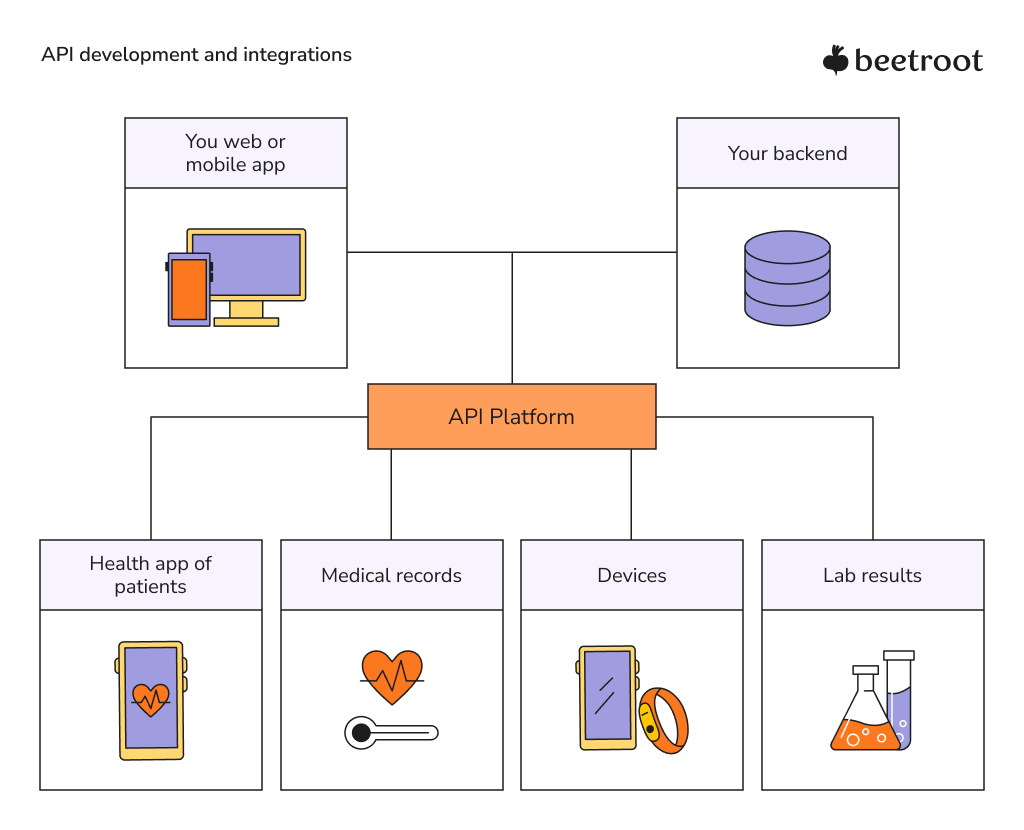
Knowledge of interoperability
The term “interoperability” refers to a seamless transmission of patient data between medical facilities and the establishment of hardware-and-software connectivity within an institution. According to HIMSS (Healthcare Information and Management Systems Society), interoperability for healthcare has four levels.
Foundational interoperability
The capacity of one IT system to transfer data to another is known as fundamental interoperability (simple transport). The receiving IT system doesn’t have to be able to comprehend the transmitted data; all it needs to do is acknowledge receipt of the data payload.
Structural interoperability
When structural interoperability is established, all data is standardized to a specific format that multiple systems or devices can read. Because the information is organized in a particular way, the receiving system detects specific data fields automatically. Organizations use various data exchange standards, such as HL7, FHIR (builds on previous standards, such as HL7 CDA, V2, and V3), SMART on FHIR, and EDI (Electronic Data Interchange).
Semantic interoperability
Semantic interoperability entails sharing data between systems with different data structures like, for example, DICOM and non-DICOM images. Using semantic interoperability, they can be transmitted and interpreted by another system regardless of the original file format or source. Yet determining what data to collect and transfer can be tricky because various systems display the same data differently. As a result, some researchers believe that only artificial intelligence is a means to achieve full semantic interoperability.
Organizational interoperability
Organizational interoperability refers to the seamless data flow between organizations with differing requirements, policies, and purposes. Although some experts say the highest level is semantic interoperability, most healthcare companies still work to establish foundational and structural interoperability. Thus, more technical innovations and governance improvements are needed to ensure this high-grade data exchange.
Core technical expertise of healthcare software developers
When choosing a development technology, it might be best to contact your IT partner for more details about the talent sourcing for the selected stacks. Let’s briefly recap what skills app developers should have to work on a healthtech project.
Native Android development
As you’re looking for experienced Android developers to either build a new native app or port an existing application to Android, below is a short list of skills your candidates need to master:

Additional skills for HealthTech development may encompass:
- HTML, SQL, XML/JSON, familiarity with RESTful APIs for successful app integrations;
- Authentication/Authorization with OpenID-Connect/OAuth2;
- Familiarity with Android Health Platform API and more.
Native iOS development
Whether you’re migrating an existing application to the latest version of iOS or developing an app for the Apple ecosystem from scratch, a native iOS developer can help.

Additional skills relevant to iOS-native medical app development can be:
- Experience implementing solutions using more advanced iOS platform features (e.g., Apple Core ML);
- Experience developing/supporting Software-as-a-Medical-Device (SaMD) solutions;
- Familiarity with Apple HealthKit.
Cross-platform development
While native iOS and Android apps are optimized for each platform, cross-platform technology is evolving, becoming a more viable, time- and cost-efficient alternative to native development. They are built using cross-platform frameworks (like React Native or Flutter), which use platform-specific SDKs from a unified API. Additional skills a cross-platform developer could possess are the same as those relevant to other types of mobile engineering.
Front-end development
Front-end developers convert UI/UX design wireframes into actual code and the application’s visual elements that end users see and interact with. Here is the short list of skills needed for this role:
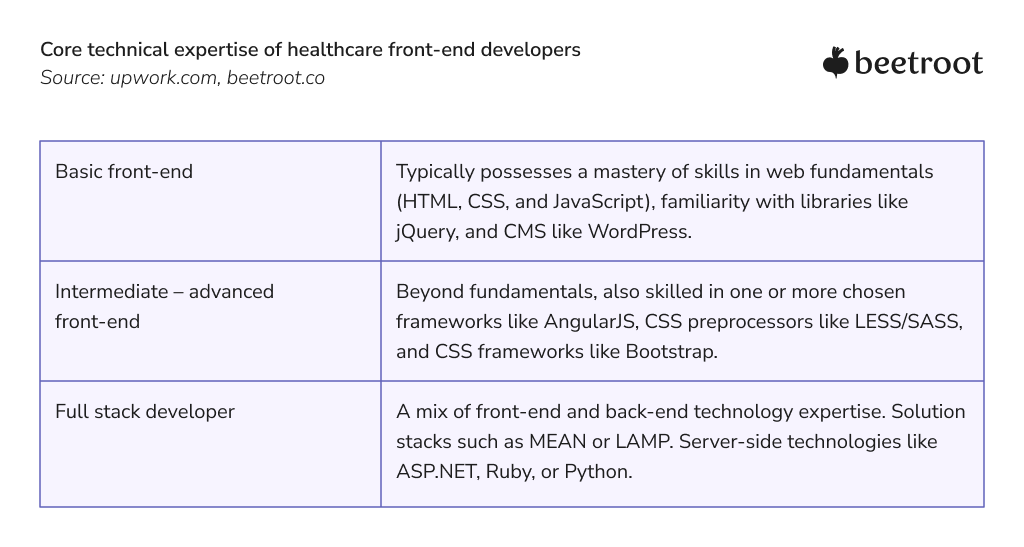
Great bonus points for your candidates will be the knowledge of:
- REST API integrations and building CRUD applications around them;
- Knowledge of Clinical Document Architecture (CDA) and/or HL7 FHIR.
- Experience with virtualization technologies (such as Docker and Kubernetes).
Back-end development
Back-end developers create the data layer, which manages interactions between the application, its database, and the server. Let’s look at the general list of skills your candidates should have:
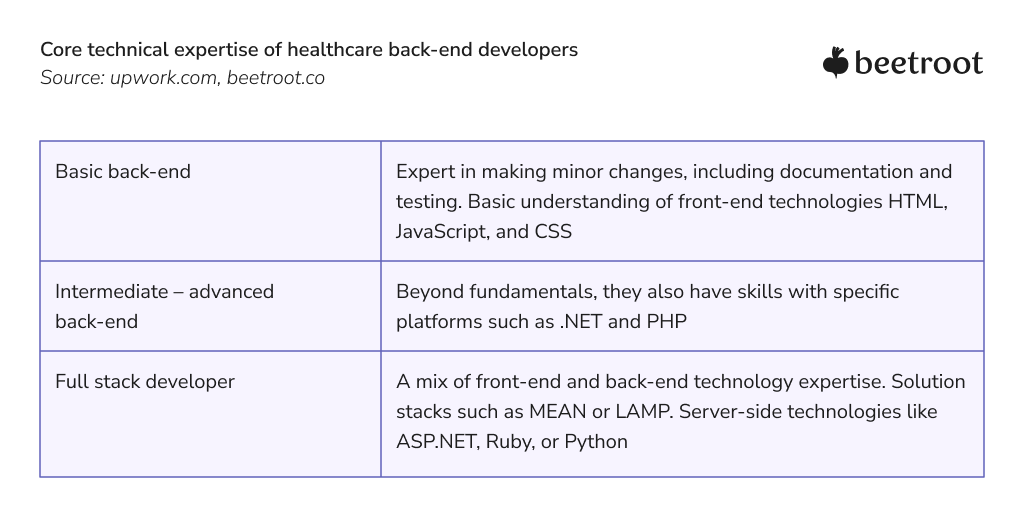
Familiarity with healthcare EMRs and interoperability principles is also a plus.
Knowledge of cloud computing platforms
Migrating to the cloud is vital for businesses to scale and maneuver uncertainty — now more than ever. The global healthcare cloud computing market is forecast to reach $89.4 billion by 2027, according to MarketsAndMarkets. Cloud-based services benefit both care providers and patients, so let’s recap the fundamentals of the technology behind them.
Types of cloud computing in healthcare
There are two types of cloud computing in healthcare: cloud computing services (based on the service model) and cloud computing environments (based on deployment).
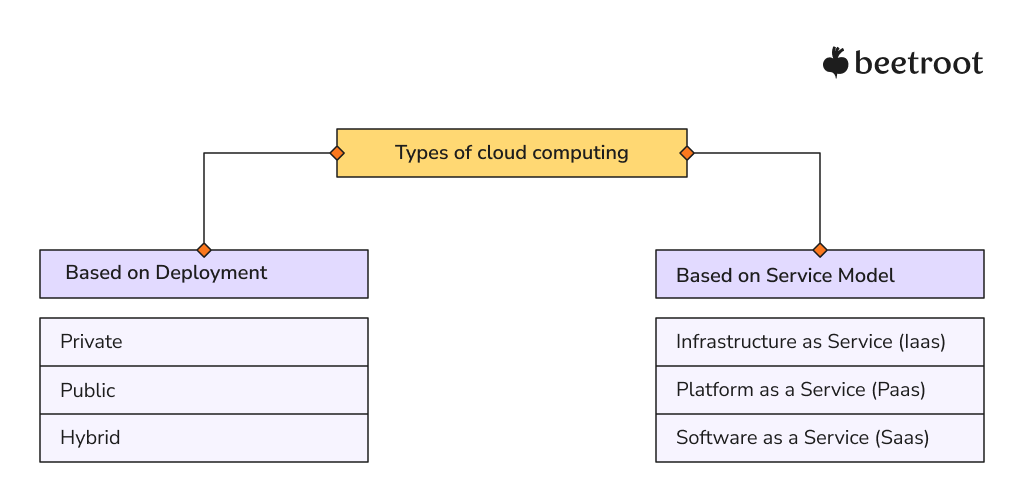
- Private clouds are implemented on organizations’ proprietary servers. A private cloud environment grants your company complete control over the data and security to meet stringent regulatory and compliance standards, but they are more expensive (the cost of hardware and maintenance);
- Public clouds can be accessed remotely via standard web clients. All data is stored remotely on secure data centers hosted by external cloud providers, the biggest of them being AWS (Amazon Web Services), Oracle, Microsoft Azure, and Google Cloud.
- Hybrid clouds are a combination of the two, held together by technology that allows for seamless data exchange between connected apps. Plus, combining public and private clouds renders more agility and helps businesses better organize infrastructure security and compliance.
The three most prevalent cloud service models in the medical field are:
- Software-as-a-service (SaaS). These subscription-based solutions negate the need for hosted services because the data is stored remotely on the provider’s side. The end users can access the services anytime via a web browser or mobile app. SaaS is commonly used in healthcare for several health IT functions, including EHRs, medical practice management, and health information exchange (HIE).
- Platform-as-a-service (PaaS) provides an organization with access to a predefined software development environment that can be used to build, test, and run apps using software development kits (SDKs). Google App Engine, web servers, and SQL servers are examples of PaaS products.
- Infrastructure-as-a-service (IaaS) technology offers on-demand computing for medical facilities, supplying the same capabilities as a traditional data center minus the maintenance. Because IaaS providers still manage the servers, hard drives, networking, virtualization, and storage. Common examples of IaaS are DigitalOcean, Linode, Cisco Cloud Solutions, Microsoft Azure, Google Compute Engine, and Rackspace.
Knowledge of next-gen technologies in health IT
Many emerging technologies, ranging from artificial intelligence (AI) to the advanced database mechanism that powers cryptocurrency, can improve and even drive the progress of mobile health applications. There are many use cases of how next-gen technology takes patient care and medical services to the next level.
AI & Machine Learning
- Intelligent patient-centric conversational chatbots;
- Medical imagery analysis and pattern identification;
- Smart patient data collection;
- Symptom tracking and analytical apps;
- ML algorithms for new drug discovery;
- Preventative medicine and treatment;
- Patient flow optimization;
- Improved resource management for healthcare settings, and more.
Internet of (Medical) Things
- Smart medical appliances for homes and hospitals;
- Wearables supporting advanced sensors (e.g., ECG and EDA);
- Traceable medicine for remote patient condition monitoring.
Healthcare Big Data
Because AI and IoT assume the generation of enormous amounts of data, a mechanism to process every bit of this info is required. As a result, designing datasets that can process billions of calculations in real time goes hand in hand with implementing ML and IoT functionality in healthcare.
Augmented (AR) and Virtual Reality (VR)
- Therapy sessions with a simulated environment in mental health treatment;
- Aid in safe surgeon training and academic classes;
- Indoor navigation in clinics;
- Embedding VR for a better explanation of conditions to bridge the doctor-patient gap;
- Assistance in therapy and session provision via mobile devices and more.
Blockchain
- Integration with multiple EHR systems;
- Medicine tracking in supply chains (delivery of medicines and vaccines);
- Decentralized patient portals with improved data security;
- Additional security and access control for medical devices.
Knowledge of application security
App security is critical when it comes to healthcare software solutions. Your app development team should implement a security mechanism that meets all regulatory requirements. Some security-related skills in developers include:
- Familiarity with MFA (multi-factor authentication) to ensure that mobile apps do not rely solely on user passwords;
- Understanding of application-level threats and how to prevent them, for example, handling denial of service attacks or scripting attacks;
- Knowledge of the encryption algorithms such as DES, RSA, and others for secure data storage and transfer;
- Familiarity with Compliance-As-Code to ensure security and standard compliance throughout all stages of mobile app development.
Soft skills
While hard skills are the primary criterion for selecting candidates for your healthcare project, they do not guarantee that a person will become an integral part of your team. So, what kind of power skills should they also bring to the table?
Good communication
For your team to be effective, it is vital to be on the same wavelength as your developers and share the same values. Excellent communication and relationship skills help to establish real interpersonal connections and create a safe work environment that is both sustainable and productive.
Teamwork
Healthcare is a collaborative, mission-driven, and impactful industry. And it is a rare case for a developer to work alone: being part of a larger ecosystem, the ability to connect to peers and support other team members allows people to stay integrated, committed, and creative in the long run.
Adaptability
The field of healthcare IT is dynamic and fast-paced, requiring all members of your team to deal with change and uncertainty. That’s why rapidly scaling companies need to look for developers who are flexible enough to cope with any growth challenges.
Empathy
In a service-oriented industry like healthcare, understanding and respecting the app audience is critical. Besides, emotional intelligence and deep comprehension of other people’s feelings and reactions help make better decisions and maintain a positive atmosphere within the team and in end-client interactions.
Self-organization and learning
The ability of your team members to quickly navigate an unfamiliar environment directly impacts their speed and performance. Self-motivation, discipline, and openness to continuous learning are some of the best qualities to look for in your candidates. After all, only people who are constantly improving their skills and employing new strategies can effectively solve more complex tasks when they emerge.
Guiding your HealthTech project to success with Beetroot
Beetroot will assist you in implementing software applications in any area of HealthTech by building or augmenting your product development team. We’re on a mission to foster sustainable growth and maximize our clients’ positive impact at scale through a purpose-driven approach reflected in:
- Partner consulting
As a tech ecosystem, we aim to generate long-term social, economic, and environmental impact, extending far beyond standard vendor services.
- Team sustainability
We believe in the sustainability and longevity of teams and design our agile units with long-term success in mind, focusing on building sustainable code in a healthy work environment.
- Cultural fit
Our clients frequently express the importance of being “on the same wave” with the Beetroot team for their product to be successful. As a nearshore software company, we ensure that no cultural clashes disrupt your project.
So whether you’re struggling with completing your team onshore, achieving interoperability, staying compliant with regulations, or seeking additional development support, our experts are ready to help.
Subscribe to blog updates
Get the best new articles in your inbox. Get the lastest content first.
Recent articles from our magazine
Contact Us
Find out how we can help extend your tech team for sustainable growth.




